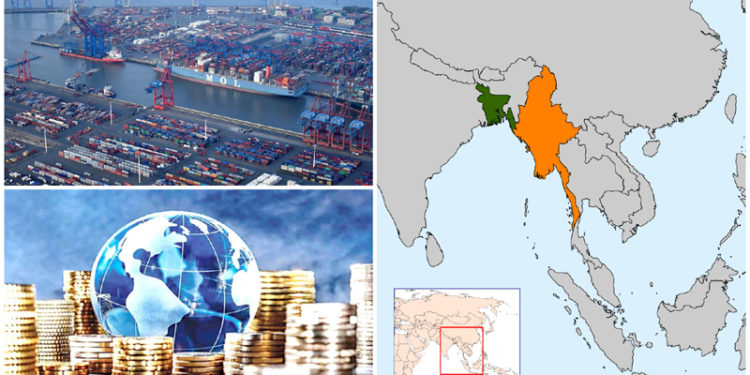Md Hasanur Rahman Tanzir – According to the World Bank, the Blue Economy is a concept that seeks to promote economic growth, social inclusion and livelihoods while ensuring the environmental sustainability of the ocean and coastal areas. The main objective of the Blue Economy is to help create jobs, increase the country’s wealth, create social capital, increase income and, above all, create a balance between saving and investment in the environment.
Belgian economist Gunter Pauli first proposed the concept of the Blue Economy in 1994. This concept gained global importance at the Rio+20 conference in 2012. Bangladesh, which has a huge area. In Bangladesh, the Blue Economy refers to the resources of the Bay of Bengal in Bangladesh. Resources extracted from the Bay of Bengal are one of the main resources of the Blue Economy in Bangladesh.
Following the settlement of maritime boundary disputes with Myanmar in 2012 and with India in 2014, a total of more than 118,813 square kilometers of maritime area now belongs to Bangladesh. It has an exclusive economic zone of 200 nautical miles and sovereign rights over all types of living and non-living resources on the ocean floor from the Chittagong coast to 354 nautical miles. Bangladesh has received 12 of the 17 blocks in dispute with Myanmar in the sea.
Bangladesh has received all 10 blocks claimed by India. Bangladesh is now benefiting economically from the use of these vast resources. And by developing this blue economy properly, a new horizon of GDP growth in the country can be opened.
Experts believe that Bangladesh has oil and gas reserves. If new gas fields are discovered here, it will become a major force in the country’s blue economy. Exploration in the country’s seas has confirmed the presence of a large amount of gas hydrates or methane gas deposits. Experts also said that it is estimated that there are 0.11 to 0.63 trillion cubic feet of potential natural gas hydrates in the exclusive economic zone of Bangladesh’s seas, which is equal to 17 to 104 trillion cubic feet of natural gas.
The core of the post-2015 sustainable development program that the United Nations has undertaken is the blue economy. According to experts, the world’s population will be about 9 billion in 2050. To provide food for this large population, the ocean will have to be relied on. Therefore, the blue economy is gradually becoming more and more popular all over the world.
The main foundation of the blue economy is sustainable ocean policies. The ocean economy is contributing to the global economy in many ways. Activities worth 3 to 5 trillion US dollars are taking place around the oceans every year. Marine fish, plants and animals provide 15 percent of the protein for the world’s 8.07 billion people. 30 percent of the world’s gas and fuel oil is supplied from various gas and oil fields on the seabed.
The blue economy has been the focus of discussion at all the international conferences held in recent years. The Asian Conference on Oceans in 2012, the Food Security and Blue Growth Conference held in Bali in 2013, etc. are particularly noteworthy. The blue economy is also at the core of the development strategies of various international organizations, including the Organization for Economic Cooperation and Development (OECD), the United Nations Environment Programme (UNEP), the World Bank, the Food and Agriculture Organization (FAO), and the European Union (EU). In addition to international organizations, various small and large countries are formulating development strategies based on the blue economy.
The majority of Indonesia’s national economy depends on the ocean. The country has recently taken steps that, if fully implemented, would be worth ten times the national budget in terms of marine resources. An article published in The Jakarta Post states that the Lombok Blue Economy Implementation Program will generate 77,000 new jobs and $114.88 million annually.
Bangladesh’s potential for developing the blue economy
The use of the marine resources of the Bay of Bengal, the Blue Economy Zone of Bangladesh, can not only provide Bangladesh with future energy security, but also change the face of the overall economy. It is even possible to earn a lot of foreign exchange by exporting seafood products abroad to meet the country’s needs. Although about 8 million metric tons of fish are caught from the Bay of Bengal every year, we are only able to catch 0.7 million metric tons. If advanced technology is used, fish harvesting can be further increased.
There is an abundance of highly migratory fish species and tuna and tuna-like fish in the deep sea at depths of more than 200 meters in the economic zone. Cosmetics, nutrition, food and medicines are available from various marine organisms, which can be sold abroad and earn a huge amount of foreign exchange. It is already possible to commercially produce various types of algae such as sphagnum moss (sphagnum moss) such as sphagnum moss-3 and sphagnum moss-6.
The country’s demand is being met by producing about 1.5 million metric tons of salt every year. By inventing and using advanced technology in salt cultivation, it will be possible to export salt abroad. Heavy minerals (heady minerals) have been found in the Bay of Bengal. Heavy minerals include ilmenite, titanium oxide, bluetile, zircon, garnet, magnetite, monazite, cobalt, and other very valuable resources. If these valuable resources can be extracted in the right way, it is possible to earn foreign exchange worth thousands of crores of taka.
90 percent of world trade is completed through maritime transport. In order to utilize this huge economic opportunity, it is necessary to quickly provide facilities to local shipbuilding companies and connect more advanced commercial ships to the existing system. By building deep-sea ports, creating facilities in Bangladesh ports, and increasing feeder service activities for international commercial ships, our ports can become more important ports like Colombo and Singapore ports. It is necessary to conduct necessary research activities in this regard very soon.
A lot of foreign exchange can be earned by extracting coastal mineral sands and minerals. By 2030, 10 percent of the world’s cobalt, copper, zinc and high-grade minerals (GHG) will come from the sea. Since Bangladesh has not conducted any research and exploration activities in this sector, it has not yet been possible to identify these valuable minerals in the Bay of Bengal. Coastal tourism accounts for 5% of the world’s GDP and employs 6-7% of the world’s people.
Bangladesh has the largest continuous sandy beach in the world with a length of 120 km. In this case, if adequate recreation and a pleasant environment can be arranged in the coastal area, it will be possible to earn a lot of foreign exchange for the country from this sector. In addition, the land area of the southern part of the country can be increased by creating artificial islands and the islands can be developed as a tourism sector through full practice. In this regard, it is necessary to undertake necessary research activities.
Electricity can be generated by using ocean waves and tides and by applying the temperature difference between the upper and lower layers of the ocean through the application of the technology of oceanographic wave energy (OEE). For this, it is necessary to conduct a lot of experimental activities along with research.
Challenges in the development of blue economy
Lack of adequate policies and proper action plans. Lack of skilled manpower. Lack of technical knowledge. Lack of accurate information about the quantity and value of resources. Inadequate research based on marine resources. Lack of international and regional communication related to blue economy. Lack of research vessels to go to sea and carry out research activities.
Plans that can be taken to implement blue economy.
Determination of baseline data related to physical and space oceanography. Identification of potential fishing zones. Launching of ocean observation and real-time data systems. Establishing baseline data for physical oceanography. Establishing baseline data for biological oceanography. Aquaculture. Enriching baseline data for chemical oceanography. Preventing coastal pollution. Developing oceanographic data centers, developing and enriching data, and developing ocean information and technology.
Creating skilled manpower for oceanography and public awareness activities on oceanography. Blue economy in Bangladesh can become an important means of economic development in the 21st century. Through planned and sustainable management, it will not only bring economic prosperity, but also play a role in conserving the environment and improving the quality of life of coastal communities. Now is the time to formulate a comprehensive roadmap to make blue economy initiatives effective.




















